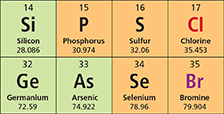CHAPTER 5 Assessment
 Interactive Textbook with assessment at PHSchool.com
Interactive Textbook with assessment at PHSchool.com
Reviewing Content
Choose the letter that best answers the question or completes the statement.
Mendeleev arranged the elements in his periodic table in order of
atomic number.
number of electrons.
mass.
number of neutrons.
Mendeleev's decision to leave gaps in his periodic table was supported by the discovery of
electrons.
protons.
argon.
gallium
In a modern periodic table, elements are arranged in order of
atomic number.
number of isotopes.
atomic mass.
number of neutrons.
How many periods does the periodic table have?
18
7
9
8
An atomic mass unit is
one twelfth the mass of a carbon-12 atom.
the mass of a carbon-12 atom.
the mass of a neutron.
the mass of a proton.
An element that is shiny and conducts electric current is likely to be a
gas.
metal.
metalloid.
nonmetal.
Copper is an example of
an alkali metal.
an alkaline earth metal.
a nonmetal.
a transition metal.
Elements that have the same number of valence electrons are
in the same period.
in the same group.
called noble gases.
called transition metals.
The most reactive metals are the
transition metals.
alkaline earth metals.
alkali metals.
metalloids.
Which elements are all gases at room temperature?
Group 1A
Period 3
Group 7A
Group 8A
Understanding Concepts
What information did Mendeleev have about the elements he organized into a periodic table?
How did Mendeleev know where to leave the spaces in his table?
Why is the table of the elements shown in Figure 7 called a periodic table?
Why does the number of elements vary from period to period?
Explain how the atomic mass of an element is affected by the distribution of its isotopes in nature.
List three ways that the elements in the periodic table can be classified.
In general, what happens to the reactivity of elements in groups labeled A as atomic numbers increase across a period?
Why don't the elements within an A group in the periodic table have identical properties?
Why was it difficult to discover the noble gases?
Use this portion of the periodic table to answer Questions 20−23.

How many of the elements shown are metals? How many are nonmetals? How many are metalloids?
Which element is a liquid at room temperature and which is a gas at room temperature?
Which of the two halogens shown is more reactive? Give a reason for your answer.
Does selenium have more in common with sulfur or bromine? Explain your answer.




